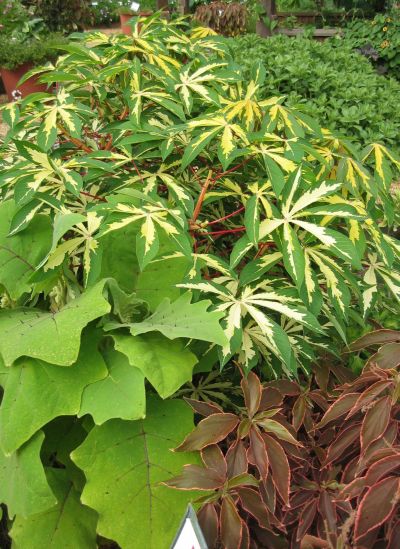Certainly not a “Best Of” list (because they’re ALL awesome, of course), just some posts throughout the year that I think got at the root of why we’re doing this and/or had some entertainment value with a message buried within. I’ve included some comments from our astute readers. And I’m not sure if I should refer to myself in first or third person.
January
Post: Holly’s “Er, too much coverage?” – using screen grabs of an AT&T commercial featuring some kind of weird vine overtaking a city – dubbed Clematis broadbandii (I hate to lead off with my own stuff, but feel this was some of my most inspired work).
Best associated comment: “I laughed so hard I cried.” – Jeff Gilman
February
Lots of great arboriculture posts in February; tree torture, girdling roots, planting tips, sewer issues, etc. But my fave post was Linda’s “Blog survey results, Part 1” She had set up an excellent survey asking what you, our readers, thought of and found most useful regarding our GP blog. The results were very helpful, and ended up in Journal of Extension manuscript (a.k.a. a refereed journal article, which keeps our administrators happy) with Jeff as the lead author.
Unfortunately, the only comment was from an apparently dissatisfied customer (thpppbbt).
March
March was the Month of Debunking. I think the post that summed it up was “Keep calm and carry on” by Bert. A nice overview of what we’re all about, as he shares his thoughts on planting hole size and amending backfill, noting in a conversation with Jeff “how frantically worked up some people about following the various landscaping ‘rules’, especially for tree planting.”
Best associated comment: “Your post confirms my experience planting thousands of trees over three decades, and dozens of trees in my own garden. However, my clients don’t believe a word of it, so it’s easier to plant with a little compost and dig a bigger (not deeper) hole than to have a client suspect you are cutting corners. Too often educating clients is perceived as just another marketing ploy.” – Dave
Honorable mention comment: “My response to that info was ‘oh thank goodness’. It was like the dentist telling you that flossing doesn’t really make a difference after all.” – plantingoaks
April
Ha! You can tell we get busier in April. Length of posts were about ½ that of winter. My choice is a great thought-provoking post from Linda, simply titled “Rain barrels.” It was basically a response to a blog post from one of our readers, where he discusses the impracticalities of rain barrels. Linda simply posted the link, added a pic of her personal rain barrel, how she uses it, and then opens the floor for discussion. Garnered 35 comments, most really thoughtful, including one from the post-in-question author.
Most asking-for-it comment: “Well now I have a new reason not to clean my gutters. With all the leaves, I am creating a great batch of compost tea!!” – jake (Jake, dear, have you not read the umpteen compost tea posts on this blog? )
May
Seemed to be the “hot issues” month. Exploding watermelons, Bt in the bloodstream, heavy metals in urban soils, invasive species. I related an exchange with a plant sale customer in the post “I’d be happy to answer any questions you might have.” One of my pet peeves is the confusion as to what a named cultivar implies; and I tried to address the question as well as that of “native-ness.”
Best comment: “purity is overrated.” – robert hart
Linda kept the discussion going by posting a guest column by fellow faculty Charlie Rowher – one of the clearest explanations that “plant breeding/crop improvement does not equal GMO”
June
Bert was in overdrive, with a slew of fabulous posts on root research, herbicide damage, native vs. exotic, etc. I gave y’all WAY too much information about my on-vacation brush with food poisoning. But Jeff had two I’d like to point out:
1) “Vinegar: a garden miracle!”
Snort! Jeff does in all the silly vinegar claims at once. Neat, tidy, and to the point.
The only retort possible w
ins: “But it does wonderful things for cucumbers… after they’re sliced and put in a bowl! ;-)” – SandyG
2) “What happens to the horticulturist?”
I believe part of what we do here at GP is explain a bit about the weird wild world of academia, especially how it relates to our discipline of Horticulture. Jeff brings a great rant on how training generalists is becoming a lost art, and the plight of horticulture departments everywhere.
Best comment, though almost as long as the post: “Great post! my two cents: Do we need more generalists? YES!! why? Because the problems/challenges/research questions we face do not respect the traditional boundaries of academic disciplines. Horticulturalists often operate at the human scale what we can see, taste, touch and feel. While research dollars are pouring in for projects that are at a molecular scale. This means lost plant id courses, and students with no idea about what they are seeing in the field. This ultimately leads to a shortage of people who can make observations about what is happening on the ground (as opposed to the lab). Big mistake! Critical thinkers need to be able to put it all together, soils, plants, insects, ecology and on and on.” – jonas
Next week – July through December!











